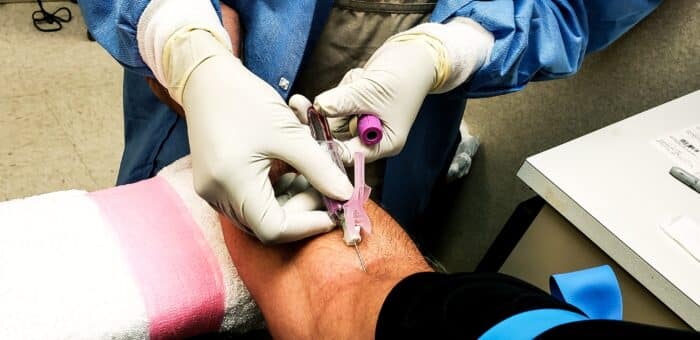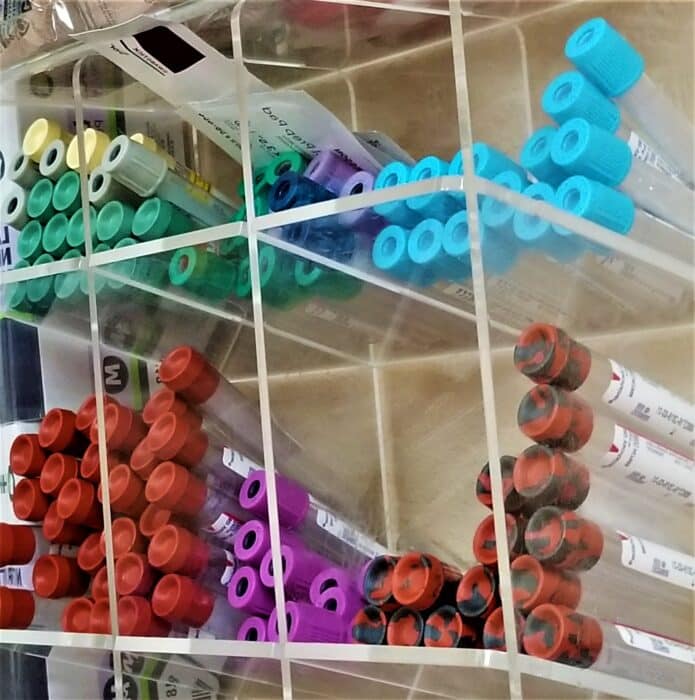If you’re someone who wants to enter the rewarding industry of healthcare but doesn’t know where to start, or which career to choose, we’ve got you covered.
If you’re also looking for healthcare careers that do not require years of schooling and thousands to be spent, you might like the idea of becoming either a phlebotomist or a Certified Nursing Assistant (CNA).
Both of these careers are excellent starting points for a smooth transition into the healthcare industry, but you might be wondering how they differ, and how to choose one best suited for you.
In this article, we will uncover the differences and similarities between a phlebotomist and a CNA, with respect to their salaries, duties, and skills.
So let’s dive right in.
What is a Phlebotomist vs. What is a CNA?
A phlebotomist is a healthcare professional who specializes in drawing blood from patients. They play a crucial role in the medical field by collecting blood samples for various purposes, such as laboratory tests, medical diagnoses, and blood donations.
Phlebotomists are skilled in using needles and other equipment to safely and efficiently collect blood while ensuring patient comfort. They must also accurately label and record blood samples to maintain patient information and ensure test results are reliable.
Phlebotomists typically work in hospitals, clinics, laboratories, or blood donation centers, where their expertise in blood collection is essential for diagnosing and treating medical conditions.
On the other hand, a CNA, or Certified Nursing Assistant, is a healthcare professional who provides essential care and support to patients or residents in various medical settings, such as hospitals, nursing homes, or home healthcare.
CNAs assist with daily activities like bathing, dressing, and eating, and they also measure vital signs, help with mobility, and provide emotional support to patients.
They work under the supervision of registered nurses (RNs) or licensed practical nurses (LPNs) and play a crucial role in ensuring the well-being and comfort of patients.
Also see: What is a Phlebotomist
Phlebotomist vs. CNA: Duties
Now that you know what a phlebotomist and a CNA are, let’s move on to their duties. Are their roles and responsibilities different?
Let’s take a look.
Phlebotomists and Certified Nursing Assistants (CNAs) have specific roles and responsibilities in the healthcare field, though they may be similar in some settings.
Here’s a breakdown of the primary differences in their duties:
Phlebotomist Duties:
- Blood Collection: Phlebotomists specialize in drawing blood from patients. They are skilled in venipuncture and capillary puncture.
- Blood Specimen Handling: They properly label and transport blood samples to the laboratory for testing, ensuring accuracy and patient safety.
- Infection Control: Phlebotomists follow strict infection control protocols to prevent the transmission of diseases and maintain a sterile environment.
- Patient Interaction: While phlebotomists interact with patients, their primary focus is on collecting blood specimens efficiently and safely.
Certified Nursing Assistant (CNA) Duties:
- Patient Care: CNAs provide direct patient care, including bathing, grooming, dressing, and assisting with activities of daily living.
- Vital Signs: They measure and record vital signs like blood pressure, pulse, temperature, and respiration rates.
- Mobility Assistance: CNAs help patients with mobility, including transferring them from beds to wheelchairs and assisting with walking or exercises.
- Nutrition and Hydration: They may assist patients with eating and drinking, ensuring they receive proper nutrition and hydration.
- Emotional Support: CNAs offer emotional support to patients, often forming close bonds with those in their care, and providing companionship.
- Reporting: CNAs report changes in a patient’s condition or behavior to the nursing staff, helping ensure timely interventions.
Read: How to Become a Phlebotomist
Phlebotomists vs. CNAs: Salary
The salaries earned by both these professionals also differ greatly. It is also important to note that the salary for phlebotomists and Certified Nursing Assistants (CNAs) can vary depending on factors such as location, experience, and the specific healthcare facility.
Let’s take a look at the differences in their salaries:
Phlebotomist Salary:
Phlebotomists typically earn a slightly higher median annual salary compared to CNAs.
According to the U.S. Bureau of Labor Statistics, the median salary for phlebotomists in the United States is $38,530.
Experienced phlebotomists with additional certifications or working in specialized healthcare settings may earn even higher salaries.
Certified Nursing Assistant (CNA) Salary:
CNAs generally earn a slightly lower mean annual salary compared to phlebotomists.
According to the BLS, the mean salary for CNAs in the United States is $35,740.
CNAs who work in certain states or metropolitan areas may earn higher salaries due to differences in cost of living and demand for healthcare workers.

Do You Want To Become a Phlebotomist? Check Out Free Phlebotomist Masterclass!
In our masterclass you learn:
- How to be a Phlebotomist faster…in just 2 months!
- Avoid student debt & driving to classes
- #1 thing employers want from Phlebotomists
- How to stand-apart & get a university certificate for a strong resume
Phlebotomist vs. CNA: Difference in Skills
You might have guessed by now how different the professions are. The skills required to become a phlebotomist vs. a CNA might also differ.
Let’s take a look.
Phlebotomist Skills:
- Drawing Blood: Phlebotomists should be really good at taking blood from people, either from their veins or just under their skin.
- Handling Blood Samples: They should know how to collect, label, and move blood samples safely for tests.
- Keeping Things Clean: Phlebotomists need to make sure everything is super clean to avoid making people sick.
- Being Very Precise: They need to be very careful to avoid mistakes when collecting blood.
- Talking to Patients: Even though they mostly collect blood, they still need to talk to patients to explain what they’re doing.
Certified Nursing Assistant (CNA) Skills:
- Helping People: CNAs take care of patients by helping them with everyday things like bathing, dressing, and going to the bathroom.
- Checking Vital Signs: They check and write down important signs like blood pressure, pulse, temperature, and how fast people breathe.
- Helping People Move: CNAs help patients move from beds to chairs, walk, and do exercises.
- Feeding and Drinking: They help patients eat and drink to make sure they stay healthy.
- Being Supportive: CNAs are there to talk to patients and give them company. They can get really close to the people they care for.
- Noticing and Reporting: They watch patients closely to see if something changes and tell the nurses about it.
Conclusion
In conclusion, both phlebotomists and CNAs play important roles in the world of healthcare, but they have different focuses and responsibilities. Phlebotomists are experts at drawing blood and handling samples, while CNAs provide essential care and support to patients in various ways.
Both professions require unique skills and are essential for ensuring the well-being of patients. So, whether you’re considering a career as a phlebotomist or a CNA, remember that each job is crucial, and the right choice depends on your interests and the kind of work you’re passionate about in the healthcare field.
See: How Long Does it Take to Become a Phlebotomist
Related Resources:
- Phlebotomist Certification
- Phlebotomist Skills
- Ultimate Phlebotomist Resume Guide – Phlebotomy Job
- Phlebotomist Duties
- What is the Difference Between a Licensed Phlebotomist and Certified Phlebotomist?
- What Do You Need To Be a Phlebotomist?
- Phlebotomy Externship
- What are the Different Types of Phlebotomy Certifications?
- Phlebotomist Nurse
- Phlebotomist Cover Letter
- Phlebotomist Lab Technician
- Therapeutic Phlebotomy
- Phlebotomy Course
- Phlebotomy Classes
- EKG Phlebotomy Technician
- Order of Draw Phlebotomy
- Phlebotomy Internship
- 4-Week Phlebotomy Classes Online
Related Articles
-
How to Be Successful in College in 2022 – 7 Simple Tips to Succeed
-
How Do Scholarships Work? Read This First…Truth is Shocking
-
7 Best College Majors 2024: What Should I Major In?
-
How to Choose a College – 10 Things You Must Consider in 2024
-
Why Go to College? Top 13 Benefits for Adult Students in 2022
-
Top 5 Best Alternatives to Community College for 2024









